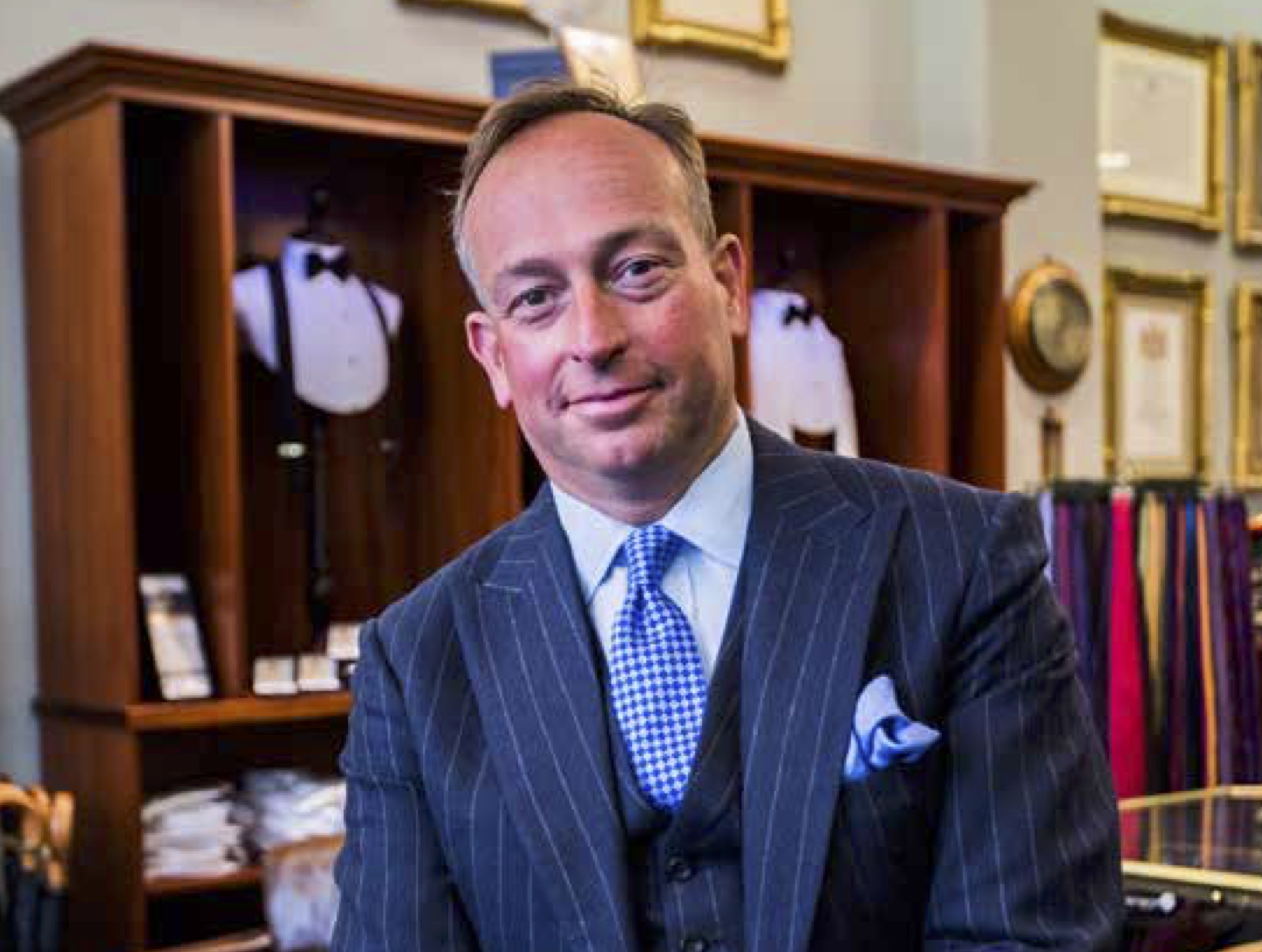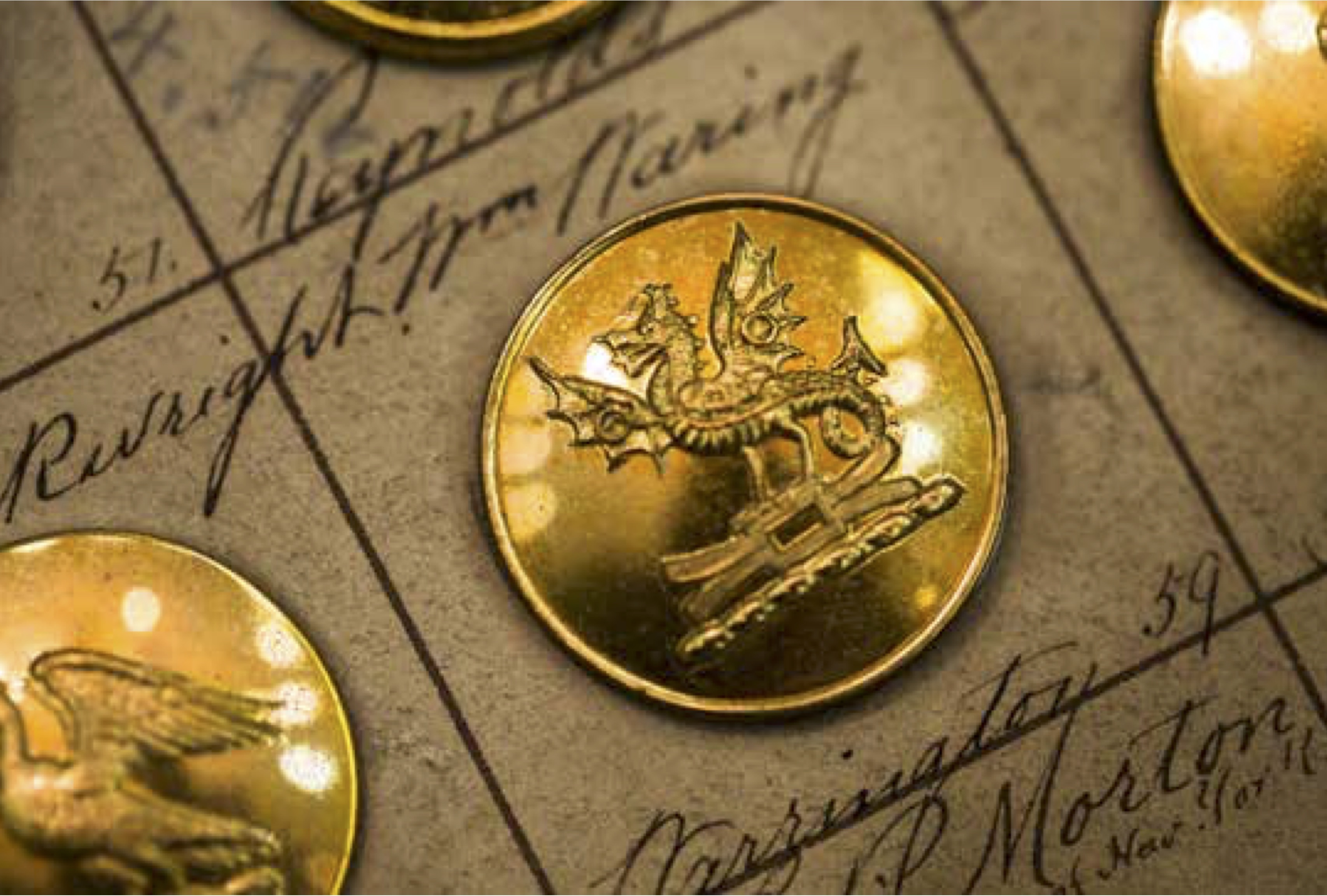Post
ARCHIVE | Where the Cutter is King
29 Apr 2020
Philippa Stockley visits the oldest tailor on Savile Row, inventor of the dinner jacket
This article first appeared in the Journal of the London Society number 469, published in 2016
“A gentleman,” says Simon Cundey, MD of Henry Poole & Co, the oldest tailor on Savile Row, “should have seven suits, three blazers,five sports jackets and trousers, a top coat, a travel coat, and a dinner suit.” That is the basic list; there is no bar to having more.
A gentleman also needs all the things that go with those items, including shirts, ties, braces, waistcoats, cufflinks, handkerchiefs (which can be jaunty) and a properly stout gentleman’s umbrella. You can buy most of these from the elegant mahogany cabinets of Henry Poole’s, still a family-run business, on what is referred to as “the Row”. The umbrellas, from eighteenth century company Swaine Adeney Brigg (founded 1750), could probably engage in mortal combat. Anyone is welcome here, in a room that resembles a club. is is one of the friendliest — yet most discreet — places in the world.
The 43 members of staff are on first-name terms, men and women of all ages, all of whom have undergone years of training as cutters and tailors and pressers. They work with one customer from start to finish, and stay with them, often for decades. Charlie the Press, real name Charlie Brooks, came to Henry Poole in the 1960s and is still here half a century later. But whatever he has seen and heard, he is not telling.
If you want a perfectly fitting, unique suit, this is paradise. You can choose from 6,000 types of cloth, 80 per cent of which are made
in Britain. They include hand-woven Scottish tweeds, Yorkshire woollens and cashmeres, Irish Donegal linens, and fine silk linings.
First you will be measured, with around 30 different measurements taken down. Then a cutter will make a pattern and in due course, after your tailor and coatmaker and presser have been hard at work, some sitting on the tables to stitch, some standing, you will have a first fitting, at which adjustments are made; then a second, at which more adjustments are made, and finally a final fitting. Here the cutter, Cundey, 47, gravely clarifies, “is king. The cutter will do the final blessing, the final check.” Only after your cutter is satisfied with every detail of the garment — from its hand-stitched buttonholes to the way it sits, giving you the famous, slightly nipped-in Poole silhouette — will it (and you) be released back into the world, to make it a more elegant place.
Have suits ever been rejected over a detail as small as a buttonhole? “Oh yes.” Whatever is not quite right will be done again. There’s no rush. One suit takes 75 hours to make, with hand stitching at every stage, and costs around £4,500. Henry Poole makes 1,100- 1,200 suits per year, and its average customer is 35-45 years old. “After the second suit, they stay for most of their life,” Cundey says.
A Henry Poole suit will last a good 10 years and has four inches put into key seams, including the shoulders (this last is unique
to Henry Poole), so that it can be let out if necessary. But not everyone admits that they’ve put on weight. Victorian American financier John Pierpont Morgan was fond of eating. “He kept gallivanting off to Paris and ate too much, and then came back for a fitting and argued about it,” Cundey explains. “But Henry Poole kept scales to weigh those customers who fibbed about their weight.”
In 1806, James Poole, a cloth merchant, came from Shropshire, and worked at No 6 Everett Street, near Russell Square, as a military tailor. His son, Henry, born 1814, learned tailoring, and after moving to Regent Street took premises in Old Burlington Street in 1826. However, he didn’t like them, but he did like the small premises at the back, which fronted on to little-known Savile Row. So he moved the shop-front there: the first tailor on the Row. Poole dressed the Prince of Wales, later King Edward VII, from 1860. It was a friendly relationship and he was granted a Royal Warrant. But he died being owed a lot of money. His cousin, Samuel Cundey, the firm’s accountant, took over the company in 1880. His son — “also a maverick” — “was a tailor and cutter, with tentacles all over Europe. He opened up in Berlin and Paris, and learned German to do it.” Then his sons took it over, and so it has gone ever since.
Winston Churchill ordered his first suit from Poole's in 1905, but it was not a lifetime relationship: “He came to us at 19 and stayed until 1940. But he got a bit behind with a bill, and after three years of gentle reminders, when he became Prime Minister, the accountant sent the bill to 10 Downing Street.” Cundey shakes his head. “My grandfather was upset for many years that he had done that without asking the advice of the cutter.” Churchill paid the bill but did not come back, one of the few customers that Henry Poole has ever lost.
There are many other stories. For example, Poole’s invention of the dinner jacket. The first, a short dark-blue silk smoking jacket, was made for the Prince of Wales in 1865, then copied for an American he invited to Sandringham, James Brown Potter, a member of New York's famous Tuxedo Club. Potter took it back there, where its popularity gained it the nickname Tuxedo. Henry Poole also makes the glamorous red and gold coats for the Queen’s carriage postilions, as well as other royal livery; coats for masters of hunts; and once, 15 years ago, a waistcoat for a monkey.
Simon Cundey’s father, Angus, had to pulp a lot of patterns during the war, (including those for Napoleon, Disraeli and Churchill)
to help the paper shortage — just as royal photographer Cecil Beaton destroyed many priceless prints. But the ledger books that hold orders, in gorgeous copperplate handwriting, for everyone from Napoleon III to Charles Dickens to Charles de Gaulle to Churchill are all still there, proudly kept, an astonishing archive of the taste of famous men.
“Today, architects are some of our most interested customers,” says Cundey. “ They get involved in the design. For a cutter thinks in 3D just as they do.” He will not, however, name any names. Along with perfect fit, perfect discretion comes as standard.
And here’s another interesting fact from this most traditional London company: Henry Poole holds more royal warrants than any other company in the world. Something that Angus Cundey, the éminence grise of tailoring, made MBE in the Queen’s winter honours, probably never even mentions.
Philippa Stockley is an artist and novelist. Her most recent book is Restoration Stories: Patina and Paint in Old London Houses

